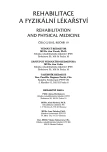Electromyographyc Analysis of the Traditional and Alternative Hoalding of White Cane
Authors:
D. Pánek 1; D. Pavlů 1; P. Belšan 2
Authors‘ workplace:
Katedra fyzioterapie UK FTVS, Praha, vedoucí katedry doc. PaedDr. D. Pavlů, CSc.
1; Sjednocená organizace nevidomých a slabozrakých ČR, koordinátor projektu Mgr. I. Slouka
2
Published in:
Rehabil. fyz. Lék., 19, 2012, No. 2, pp. 85-89.
Category:
Original Papers
Overview
This case report study analyzed the degree of muscular activity and timing in selected muscles of upper extremity (humeral cluster) with three different kinds of the grip during walking with the white stick. The electromyographic activity of m. flexor carpi radialis dx, m. extensor carpi ulnaris dx, m. biceps brachii dx, m. triceps brachii dx, m. tibialis ant dx, upper part of m. trapezius dx, m. tibialis anterior and upper part of m. trapezius sin was evaluated in two blind probands during walking without previous training with and without obstacles and gradually with all three different kinds of the white cane. The results of the study suggest that primary training in the stick may cane be one of the key moments in subsequent formation of motion stereotypes, which become emphasized during walking in the environment under load. The upper sc. alternative white cane, displayed decreased activity in trapeze muscles, which belong, in more general association, among the indices of starting overload of upper extremity. In the conclusion the authors suggest that sc. alternative white cane, will become one of the following variants in the white cane.
Key words:
white cane, EMG analysis, alternative hoalding of white cane
Sources
1. BELŠAN, P.: Ústní sdělení, Praha, říjen 2011.
2. BELŠAN, P.: Alternativní držení a ovládání bílé hole s rukojetí, která je opatřena krátkou příčkou. In: Metodické texty projektu Specializace pedagogických pracovníků na výuku prostorové orientace zrakově postižených, SONS ČR, Praha, 2012.
3. HOOVER, R. E.: The cane as a travel aid. In P. Zahl (Ed.): Blindness: Modern approaches to the unseen environment. New York, Hafner Publishing Company, 1963.
4. CHEUNG, K. K. W., AU, K. Y., LAM, W. W. S., JONES, A. Y. M.: Effects of a structured exercise programme on functional balance in visually impaired elderly living in a residential setting. Hong Kong Physiotherapy Journal, 2008, 26, s. 45-50.
5. STRAW, L. B., HARLEY, R. K.: Assessment and training in orientation and mobility for older persons: program developing and testing. Journal of Visual Impairment & Blindness, 85, 1991, 3, s. 291-296.
6. STRAW, L. B., HARLEY, R. K., ZIMMERMANN, G. J.: A program in orientation and mobility for visually impaired persons over age 60. Journal of Visual Impairment & Blindness 85, 1991, 3, s. 108-113.
7. VIRGILI, G., RUBIN, G.: Orientation and mobility training for adults with low vision (Cochrane review). Cochrane Database of Systematic Reviews, 2010, Issue 5.
8. WIENER, P.: Prostorová orientace zrakově postižených. 3. vydání, Institut rehabilitace zrakově postižených – fakulta humanitních studií UK, Praha, 2006, s. 65.
9. ZIJLSTRA, G. A. R., Van RENS, G. H. M. B., SCHERDER, E. J. A., BROUWER, D.M., Van der VELDE, J., VERSTRATEN, P. F. J., KEMPTEN, G. I. J. M.: Effects and feasibility of a standardised orientation and mobility training in using an identification cane for older adults with low vision: design of a randomised controlled trial. BMC Health Services Research, 2009, 9, s. 153-164.
Labels
Physiotherapist, university degree Rehabilitation Sports medicineArticle was published in
Rehabilitation & Physical Medicine

2012 Issue 2
Most read in this issue
- The TEST According to Véle or the VÉLE-TEST
- Riding a Bicycle and Patellofemoral Compartment Syndrome
- Mechanical Diagnostics and Therapy – Advantage of the Treatment According to McKenzie
- Early Results Following Rehabilitation of Conservatively Treated Distal Radius Fractures
